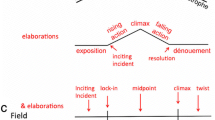Abstract
This paper proposes a CG movie creation support system which automatically generates appropriate shot transitions to make the movies more comprehensible. First, we propose a shot transition model, and then, to examine the validity of the proposed model, we analyze shot transitions in TV programs. Finally, based on the data analysis, a CG contents creation system will be implemented.
Access this chapter
Tax calculation will be finalised at checkout
Purchases are for personal use only
Preview
Unable to display preview. Download preview PDF.
Similar content being viewed by others
References
Shen, J., Miyazaki, S., Aoki, T., Yasuda, H.: Intelligent Digital Filmmaker DMP. In: Proceedings of Fifth International Conference on Computational Intelligence and Multimedia Applications (ICCIMA 2003), pp. 272–277 (2003)
Friedman, D., Feldman, Y.: Knowledge-Based Formalization of Cinematic Expression and Its Application to Animation. In: Proceedings of Eurographics 2002, pp. 163–168 (2002)
Okamoto, M., Nakano, Y.I., Nishida, T.: Toward enhancing User Involvement via Empathy Channel in human-computer interface design. In: Proceedings of IMTCI (2004)
http://www.umsl.edu/~sauter/analysis/fables/fall2002/king_castle.html
Kraft, R.N.: Rules and strategies of visual narratives. Perceptual and Motor Skills 64, 3–14 (1987)
May, J., Dean, M.P., Barnard, P.J.: Cinematography and interface design. In: Nordby, K., Helmersen, P., Gilmore, D.J., Arnesen, S. (eds.) Human-computer interaction: Interact 1995, pp. 26–31. Chapman & Hall, London (1995)
Nakano, Y., Murayama, T., Nishida, T.: Multi-modal Story-based Communication: Integrating a Movie and a Conversational Agent. IEICE Transactions, Special Issue on Human Communication (2004) (to appear)
Author information
Authors and Affiliations
Editor information
Editors and Affiliations
Rights and permissions
Copyright information
© 2005 Springer-Verlag Berlin Heidelberg
About this paper
Cite this paper
Okamoto, K., Nakano, Y.I., Okamoto, M., Huang, HH., Nishida, T. (2005). Generating CG Movies Based on a Cognitive Model of Shot Transition. In: Khosla, R., Howlett, R.J., Jain, L.C. (eds) Knowledge-Based Intelligent Information and Engineering Systems. KES 2005. Lecture Notes in Computer Science(), vol 3683. Springer, Berlin, Heidelberg. https://doi.org/10.1007/11553939_120
Download citation
DOI: https://doi.org/10.1007/11553939_120
Publisher Name: Springer, Berlin, Heidelberg
Print ISBN: 978-3-540-28896-1
Online ISBN: 978-3-540-31990-0
eBook Packages: Computer ScienceComputer Science (R0)





